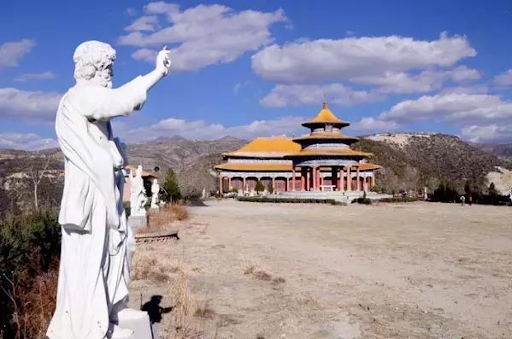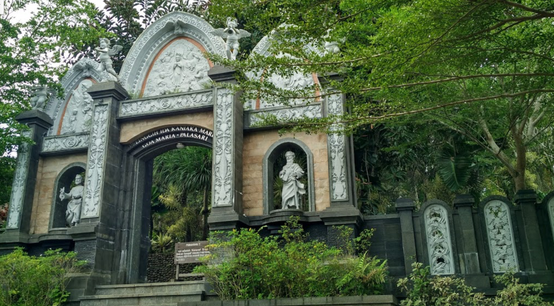Can You Guess Where These 17 Styles Of Catholic Churches Are From?
- Shane Jenkins

- Aug 16, 2020
- 14 min read
Updated: Aug 19, 2020
"The Church has not adopted any particular style of art as her own…. The art of our own times from every race and country shall also be given free scope in the Church, provided it bring to the task the reverence and honor due to the sacred buildings and rites".
Sacrosanctum Concilium, no. 123
(Quiz will follow brief introduction. It may be easier to read the answers on a computer than on a mobile device.)
For Catholics living in America and Europe, many styles of church architecture and decoration are familiar, recognizable, and effective. Those churches built in pre-modern styles, often fall into the categories of Basilicas, Gothic, Byzantine, or Baroque, to name a few. Of the churches built in the spirit of modernism following Vatican II, they may vary significantly in appearance, but they often share a tendency for experimental forms or minimalist design.
This is not an essay seeking to malign or elevate any particular style. For that issue, I believe the constitution referenced above would be a wiser read than some Catholic fanboy's blog post.
Rather, I recently discovered that outside of these recognizable, western styles of churches I had little awareness of any architectural innovations that had arisen in other communities and cultures. Upon realizing this, I set out to explore what churches, if any, I had been missing out on. I now can say with gratitude that Catholic communities around the globe have sporadically taken adventurous steps in creating spaces that reflect the the Truth through the local identity.
Here below, therefore, I have created a tour of sorts to encounter 17 of these foreign, but familiar, spaces. Try to guess where these churches are located, if you can! I've included the answer at the end of each section. Otherwise, simply enjoy this montage of organic styles and traditions, hopefully widening our perspective on church architecture.
Lastly, I want to distinguish which kinds of churches I have chosen to include here. Many non-western parishes still worship in beautiful basilicas, gothic chapels, and modernist 'megaliths.' But unless these buildings reflect the distinct local culture in a way that is discernible from same style of building in the west, I have decided to leave it out. In fact, more often than not, these local parishes choose to mimic traditional western styles for their churches or they succumb to the simple, homogenous, but cost-effective churches that modern building techniques have engendered. All the more reason to highlight the few churches that defy the trend. To highlight what I mean, can you tell which of these churches is from Japan, East Africa, and suburban America?
Answer (Highlight the area between brackets to reveal):
[ 1st image: Saint Joseph's Catholic Church. Sylvania, Ohio.
2nd image: Kichijoji Catholic Church. Tokyo, Japan.
3rd Image: Regina Mundi Cathedral. Bujumbura, Burundi. ]
All the same, discovering that these rare churches exist is all the more exciting! The creative decision to include or exclude certain churches, however, is entirely my own and doubtlessly will not please every reader. But this post was never meant to be an encyclopedia, just a fun tour! So I hope you can enjoy what I have collected for you, and if you have any additional examples I'm sure we would all love to see them in the comments!
1) Can you guess this church's location?
Answer (Highlight to reveal):
[ Yanshui Holy Spirit Church, Tainan City, Taiwan. ]
.
.
.
.
.
This church, situated in Tainan City, the spiritual capital of Taiwan, borrows from the wealth of style and ornamentation seen in the city's numerous shrines from other traditions. As compared with China's turbulent periods of Catholic freedom followed by suppression, Taiwan's Catholic churches have experienced relative stability and often make full use of the local artistic tradition.
2) How about this tropical chapel?
Answer:
[ Parroquia de la Santa Cruz / Hanga Roa, Easter Island. ]
.
.
.
.
.
This chapel is the only Catholic church on remote Easter Island, which lies 2,300 miles west of Chile in the Pacific Ocean. Wooden carvings of traditional Catholic figures adorn the sanctuary and the carvings on the front of the church appear to be frequently painted different, bright colors.
3) Where is this triangular church?
Answer:
[ Cathedrale Christ Roi de Mushasha, Gitega, Burundi. ]
.
.
.
.
.
This church, latticed with triangular windows, is the cathedral church of Gitega, the capital of Burundi. Burundi's Catholic population numbers around 50-60% of the country's total population and the Archdiocese of Gitega contains over a million members.
4) Which country can claim these lovely lowland churches?
A)
Name: [ Église Sainte Thérèse. ]
B)
Name: [ Catholic Church, Koh Roka. ]
Answer for both: [ Cambodia. ]
.
.
.
.
.
These two churches are found in Cambodia, a region where Catholic worship has had a turbulent past. Shifting drastically between periods of religious persecution and also welcoming Catholic refugees. The Church in Cambodia now exists in a time of relative peace.
Note the flooding in the first photo of church B and the raised foundation posts seen in the second photo. Making use of local building techniques honors the wisdom of indigenous practices. Furthermore, the four paintings in the church at Koh Roka depict the life of St. Clare of Assisi through the eyes of local imagery.
5) Where can you find this temple-looking church?
Answer: [ Cathedral of the Sacred Heart, Dali, China. ]
.
.
.
.
.
This iconic church is one of China's oldest Catholic churches built intentionally in the spirit of the local style. See this fascinating article by The Institute for Sacred Architecture for the story of China's relationship with building and rebuilding Catholic churches, such as these:
Saint Joseph Cathedral at Guiyang and Our Lady of Seven Sorrows Catholic Church (pilgrimage site) at Dongergou Village, Shanxi.
6) Which city is home to these neighboring parishes?
A)
Name: [ Church of St. Michael Nkembo. ]
B)
Name: [ Notre Dame de Lourdes. ]
Answer: [ Libreville, Gabon. ]
.
.
.
.
.
These two churches can nearly be seen from one another. Situated on a hill over the coastal city, they tell the tale of two different results from colonial influence. Notre Dame de Lourdes bears a canny resemblance to indigo porcelain, a unique form of decoration among the many colonial churches of West Africa. The more recent Church of St. Michael Nkembo, however, feels more distinctly West African. It similarly uses breeze blocks for natural air flow through the walls, but makes far greater use of wood and organic materials in its construction. Complex carvings, pillars, and mosaics exist proudly throughout the structure of the church.
7) Which city can claim this elegant, minimalist church?
Answer: [ Holy Redeemer Church, Bangkok, Thailand. ]
.
.
.
.
.
Constructed in 1954, Holy Redeemer Church was built with traditional Thai architecture in mind, while also adopting minimalistic design. Each side of the church bears a massive frieze depicting half of the Stations of the Cross.
8) Where is this convent's chapel located?
Answer:
[ Our Lady of Akita Shrine and Convent, Akita, Japan. ]
.
.
.
.
.
Our Lady of Akita shrine and convent carries spiritual import for Catholics in Japan and around the world. Home to a famous wooden carving of the Holy Mother, the statue has been credited with miraculous healings, visions, and physical manifestations such as crying, bleeding, and the stigmata. As for the chapel, the convent has this to say: The chapel of Seitai Hoshikai, called Our Lady of Akita, was done in a Japanese "irimoya-juso-style" architecture which was built by Japanese temple building carpenters from Urano Domiya Kogei, Takasaki City in Gunma. The reason this church was constructed in this traditional style was to convey to the Japanese people that the Catholic Church is universal and that Jesus Christ is the savior of all people—including the Japanese.
9) Where is this shrine to local Catholic martyrs?
Answer:
[f]
.
.
.
.
.
Marrakech's Church of the Holy Martyr's commemorates the sacrifice of the first Franciscan 'protomartyrs' who travelled to Marrakech in the 1200s. Situated directly across the street from a mosque, and built like a near mirror image, this church is recognized by many in Marrakech for the silent message it sends about Morocco's growing religious tolerance.
10) Which country is home to this imposing church?
Answer:
[ St. Joseph Catholic Church, Mandalay, Myanmar / Burma.]
.
.
.
.
.
Located in Burma's cultural capital of Mandalay and just a short walk from the former Royal Palace compound, St. Joseph Catholic Church has to establish its identity among the cities numerous 19th century royal constructions, monasteries, and pagodas. The Catholic community in Burma shares a similarly troubled history to Cambodia's Catholics, including lingering discrimination for Christianity's ties to colonialism and the west. European and missionary influence is evident in the architecture of the church, but the subsequent coloring and decoration has been customized to the community's unique preferences.
11) Which city is host to this rare cathedral?
Answer: [ Assumption of the Blessed Virgin Mary Cathedral, Kathmandu, Nepal. ]
.
.
.
.
.
This cathedral, located in Kathmandu, Nepal, carries a somber historical significance. Since the 18th century, the Nepalese state has held a strict stance of opposition to any Christian activities. Until 1951, missionaries were banned from the country and for the subsequent 50 years Christians weren't guaranteed religious liberty. Only recently, after Nepal officially declared itself a secular state, have some religious liberties been provisionally allowed, but proselytism or attempts to convert of any kind remain illegal. Assumption of the Blessed Virgin Mary Cathedral is the first and only Catholic church permitted to exist by the state since the oppression began. The church currently serves all of Nepal's 10,000+ Catholics. Tragically, however, the community has continued to face violent discrimination. On May 23, 2009, which was the same day the Parliament elected the prime minister, a bomb was placed under a seat among the faithful and detonated during a prayer service, leaving three dead and thirteen wounded.
12) Hint: The countries "_____" and "South _____"
A)
Name: [ St. Matthew's Cathedral, Khartoum.. ]
B)
Names: [Catholic Church in Nzara and Church Of The Holy Trinity in Juba.]
Answers: [ Sudan and South Sudan, respectively. ]
.
.
.
.
.
Though built in neighboring countries, these churches might as well exist in separate worlds. St. Matthew's Cathedral exists in the massive city of Khartoum, Sudan among a predominance of mosques. The church's exterior fits in well with neighboring building styles and materials, almost blending into the ground it was built upon.
The two churches from South Sudan, however, exist in a wholly different demographic context, one that is more favorably Christian, and appear to rely on more simplistic and rural building techniques. Not to diminish the effectiveness and ingenuity of these churches, however, they appear to cleverly manipulate their bricklaying for decoration and maximize their given resources with traditional building techniques to make earthen benches.
13) Where is this pacific church?
Answer:
[ Paróquia São Pedro e São Paulo, Lospalos, Timor-Leste. ]
.
.
.
.
.
The parish of Sts. Peter and Paul is one of the most architecturally notable churches in East Timor. Breaking the mold of other parishes on the island, this church incorporates the sacred architecture of the indigenous tradition. East Timor is unique among Pacific nations as one of the only majority Catholic countries in the region; Catholics number 98% of the total population. Another unique aspect of East Timor culture is that both colonial and indigenous architecture have survived well into the present day, a rarity in a world where local building styles are often eclipsed by cheaper modern building techniques.
14) Which country are these pastel-colored churches from?
A)
Name: [ Huyện Sy Church. ]
B)
Name: [ Nhà Thờ Cha Tam. ]
C)
Name: [ Nhà thờ Tân Định. ]
Answer: [ Ho Chi Minh City, Vietnam. ]
.
.
.
.
.
Again, similar to other Southeast Asian countries, Vietnam's Catholic churches carry the legacy and influence of European colonialists, seen here in the presence of French Neo-gothic architecture. Where Vietnam's Catholics have left their own mark is in the colorful decoration of the country's many churches. Nhà thờ Tân Định Church in particular has become an iconic, pink landmark of the city, popular with tourists, for its lurid or fairyland-style paint job.
15) Which sister cities are these three churches from?
A)
Name: [ Basilique Saint-Anne de Brazzaville. ]
B)
Name: [ Paroisse Christ Roi. ]
C)
Name: [ Paroisse Universitaire Nodassa. ]
Answer: [ A) Brazzaville, Republic of the Congo and B/C) Kinshasa, Democratic Republic of the Congo. ]
.
.
.
.
.
Brazzaville and Kinshasa are two capital cities which face directly opposite each other on the Congo river. Each city and their respective countries are still managing the lingering effects of French and Belgian colonialism, inner-conflict, and long-term rulers, but both also seem hopeful for the future as the two cities become more and more inter-connected.
The story behind the construction of the Basilique Saint-Anne de Brazzaville is of particular interest. Commencing on March 13, 1943, the construction of this church coincided with the German occupation of France. During that interim period, Brazzaville was named as the capital of Free France under Charles de Gaulle. The French state was encouraged by the thought of this new, symbolic construction taking place during their nation's darkest hour. Thanks to the creativity and innovation of French, Protestant architect Roger Lelièvre (Erell) and Fr. Charles Lecomte, this church was made into a reality (though not totally completed until many decades later, the final spire being completed in 2011). Roger Erell is credited with envisioning the astonishing fusion of European technical knowhow and local cultural artistry. For the first time, he brought indigenous artists such as Benoit Konongo into a large colonial construction site. Erell would continue on to envision many of Brazzaville's iconic landmarks, incorporating local inspiration at every step. I believe that the type of local purple sandstone he was known for using can be seen in the walls of the second church, Paroisse Christ Roi.
And now the two BIG ones. These regions had so many incredible churches that I had to include a good many of them. But even with that, I only scratched the surface of what these countries have to offer.
16) Which country is home to these indigenous-styled churches?
A)
Name: [ Catholic Church of Stella Maris Pluit. ]
B)
Name: [ Catholic Church of the Holy Spirit of Babakan Parish, Canggu. ]
C)
Name: [ Gereja Katolik Redemptor Mundi, Dukuh Kupang. ]
D)
Name: [ Gereja Katolik Santa Maria Immaculata, Dajan Peken. ]
E)
Name: [ Gereja Katolik Tritunggal Maha Kudus, Dalung. ]
F)
Name: [ Gereja Kristen Katolik Yesus Gembala Yang Baik, Ubung. ]
G)
Name: [ Gereja Paroki Roh Kudus Labuan Bajo, Komodo. ]
H)
Name: [ Holy Spirit Cathedral, Denpasar. ]
I)
Name: [ Paroki Hati Kudus Yesus, Ekasari. ]
J)
Name: [ Paroki Santo Yoseph, Denpasar. ]
K)
Name: [ Sacred Heart of Jesus Catholic Church, Ganjuran. ]
Answer: [ Indonesia. Particularly around the island of Bali. ]
.
.
.
.
.
Indonesia, a nation of around 267 million people, is home to nearly 7.5 million Catholics. Though much of this Catholic population has come into existence within the past 200 years, the churches which these communities created are nothing short of stunning. Like Indonesia's neighboring countries, western or modern-styled cathedrals and churches can still be found throughout the region, but Indonesia has perhaps more indigenous inspired churches than any other country in Southeast Asia.
The prominence of orange, gray, and wooden materials along with the complex towers and roofs can be traced back directly to the Javanese and Balinese Hindu-Buddhist temples across the region. Yet, these churches are never mere imitations or appropriations of these traditions. They were often built by locals for locals and always use the language of the native artwork to tell their own story. It also appears that each parish consciously adopts the subtle differences in architectural style that the many regions of Indonesia are known for; whether that be the specific style of roof used in the community or blending in with traditional architecture, such as the Balinese Hindu puras.
The final church K, Sacred Heart of Jesus Catholic Church in Ganjuran, embodies this phenomena considerably well. One of the oldest Catholic churches in its region, the Ganjuran parish was initally founded by a Dutch family who owned the local sugar factory. Slowly, however, the community began to grow and take on more native Indonesian members (at the same time, the Dutch factory owners were trying to figure out how to implement better rights for their workers as outlined in the encyclical Rerum Novarum). The church that the family decided to build for this growing community was to be built by local artisans with an eye for creating an authentic experience for indigenous parishioners. The church was built with the iconic local stone, contained intricate wooden carvings, exhibited statues of Jesus and Mary depicted in the fashion of Javanese royalty, allowed fresh air to flow through the open side walls, and featured a separate shrine to Jesus in the form of a Javanese Hindu temple. According to Wikipedia (sorry, I couldn't verify the quote myself), Dutch scholar of Indonesian culture M. C. Ricklefs considered the Ganjuran Church as one of the most impressive manifestations of the Catholic Church's incorporation of Javanese culture.
And FINALLY,
17) Which ancient, Christian region contains these churches?
A)
Name: [ Madre De Deus Church (Vettukadu Church). ]
B)
Name: [ Mount Carmel Church, Ramapuram. ]
C)
Name: [ Our Lady of Good Voyage Church, Vishinjam. ]
D)
Name: [ Queen of Peace Malankara Catholic Basilica, Palayam. ]
E)
Name: [ Sacred Heart Latin Catholic Church, Thrissur. ]
F)
Name: [ St. Francis Xavier's Church, Kaloor. ]
G)
Name: [ St. Hormis Syro Malabar Catholic Church. ]
H)
Name: [ St. John's Cathedral, Tiruvalla. ]
I)
Name: [ St. Mary's Church, Mulagumoodu. ]
J)
Name: [ St. Mary's Malankara Syrian Catholic Cathedral, Pattom. ]
K)
Name: [ St. George's Forane Church, Edappally. ]
Answer: [ Kerala, India, and nearby areas. ]
.
.
.
.
.
After spending all of this time exploring the depths of non-western church architecture, we cannot forget about our Eastern-Rite Catholic brothers and sisters. Kerala, India in the southwest region of the country has the most ancient ties to Catholic tradition of any of the aforementioned countries. It was here that the Apostle Thomas is believed to have traveled and evangelized, planting the seeds of what would remain a distinctly Christian community (For an interesting read on what St. Thomas did once he arrived in India, read up on the story of the Seven (and a Half) Churches). Today, three major Catholic rites exist in Kerala and the rest of India: in the Eastern Rite, the Syro-Malabar Catholic Church and the Syro-Malankara Catholic Church contain the majority of the region's Catholics, and then a lesser number of Latin Rite Catholics also exist.
In the region of Kerala, Catholic and Christian churches abound in every shape and size, often incorporating a multitude of foreign styles (e.g. in church E a statue of St. Francis appears to look very much like the Buddha and in church C the building could quite possibly be taller than it is long, not too unlike some Hindu temples). But all the while, these spaces create a distinct character and language to their architecture. In a move that would likely disturb a good few western observers, however, a common nocturnal decoration for these churches is the use of colored spotlights, neon, and string lights to illuminate the church in an entirely different way than can be seen during the day. This trend can be seen periodically across Southeast Asia, but perhaps nowhere as prominently as in India.
Perhaps the most visibly astonishing of these churches is the final church, or rather pilgrimage site, St. George's Forane Church at Epaddally (K). Considered to be one of the region's oldest churches, built after St. Thomas's original seven and a half churches, St. George's Forane Church has been built, rebuilt, and expanded upon over the past 1400+ years. It is the largest singular shrine to St. George in all of Asia and is visited by over five million pilgrims each year. The third, and most recent, iteration of the church was begun in 2001 with a blessing from Pope John Paul II. To quote Wikipedia's article on the matter:
The octagonal, 141-foot-high (43 m) church covers a 88,000-square-foot (8,200-square-meter) area, and is one of India's largest churches. Blending European and Keralite architecture, its madbaha/altar is made of teak covered with gold foil imported from Italy and it has two bell towers. Old [...] and New Testament [...] scenes are depicted as sculptures. The altar, depicting the Resurrection, is surrounded by carvings in Vietnamese marble. The 19,500-square-foot (1,810-square-meter) main chapel has a capacity of 5,000, and the entire church can hold 10,000 people. The two older churches have been preserved for their historic importance.
To include more examples of Indian church architecture beyond this historic region would require another article in and of itself. Suffice it to say that this region has hopefully and proudly expressed its unique Catholic tradition for over a millennium and a half. If you are looking for a fascinating, authentic, but possibly strange type of Catholic church, be sure to explore the many parishes dotted across the subcontinent.
All in all, thank you for witnessing this mini-research project of mine if you have made it this far! My work is perhaps far from professional and certainly only scratching the surface of academic. I just wished to share with you the knowledge that many communities around the world have created their own beautiful and complex expressions of the Catholic Truth through their adaptations of church architecture. For those who are curious about how I sought out these churches, I honestly just have to thank the (sometimes) wonderful gift that is Google Maps. I would never have been able to find these churches, let alone photos of them sometimes, if it weren't for the wealth of information contained there. After tens of hours exploring, I am happy to present this finished product to you. If you would like to try exploring for yourself, just type "Catholic Church near X" into the Google Maps search bar, and hopefully you will be surprised!
All the best, and may you find joy in discovering something new and beautiful as this project has done for me. -Shane Jenkins

































































































































































































































































































































































Comments